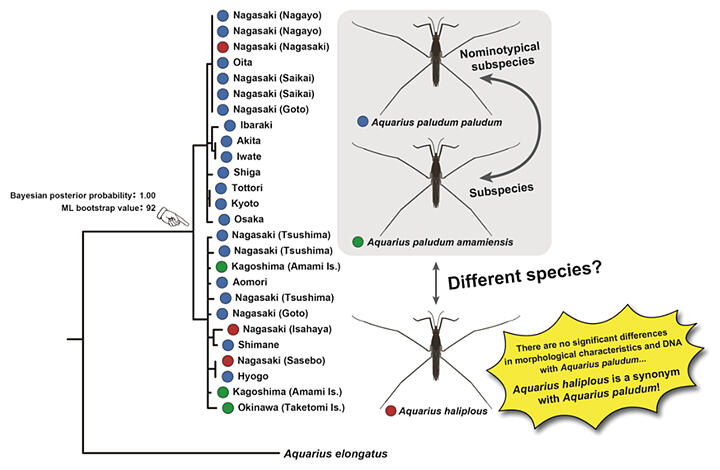A research group led by Associate Professor Shin‐ya Ohba and graduate student Naoki Hiraishi from the Faculty of Education at Nagasaki University, and Program‐Specific Researcher Tomoya Suzuki of Kyoto University and Ryosuke Matsushima (independent scholar) have concluded that the Japanese water strider Aquarius paludum paludum, which is widely distributed in Japan, and the Aquarius haliplous, which was newly recorded in 2018 and is believed to live in the brackish waters of Omura Bay in Nagasaki Prefecture, are the same species of water strider, as they are not clearly distinguishable by molecular phylogenetic analysis and morphological comparisons. Their findings were published in Entomological Science, the English language journal of the Entomological Society of Japan.

Provided by Nagasaki University
The Aquarius paludum paludum is found in rivers in various regions of Japan, and it is not uncommon to find it in brackish water. It is assumed that water striders living in brackish waters after being washed away from its original habitat in rivers to the mouths of rivers due to swollenness caused by heavy rains and other reasons were identified as Aquarius haliplous. Aquarius paludum paludum were frequently observed, especially in the low‐salinity waters of Omura Bay, but the results of analyses of this time did not indicate the presence of an independent species, Aquarius haliplous.
On the other hand, Aquarius paludum amamiensis, a subspecies of the Aquarius paludum paludum and distributed in the Nansei Islands, is genetically indistinguishable from the Aquarius paludum paludum, but can be distinguished morphologically, while the water strider Aquarius elongatus is genetically and morphologically distinct. As a result, the Aquarius genus of water striders distributed in Japan consists of two species and one subspecies: Aquarius paludum paludum and a subspecies, Aquarius paludum amamiensis, and Aquarius elongatus.
This article has been translated by JST with permission from The Science News Ltd. (https://sci-news.co.jp/). Unauthorized reproduction of the article and photographs is prohibited.




